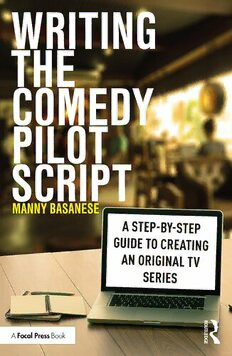Table Of ContentWriting the Comedy Pilot Script
Navigating through the challenging process of writing a comedy pilot, this
book will help screenwriters to create an original script for television. Practical
and accessible, the book presents a step-by-step guide focusing on the key
elements of the process.
Incorporating both the history of TV comedy as well as its current evolving
state in this age of the dramedy and an ever-increasing variety of broadcast and
streaming platforms, the book will serve as a guide for the fledgling sitcom
scribe. Author Manny Basanese breaks down the comedy pilot writing process
from what may be perceived as an overwhelming, time-consuming mission
into a series of much more manageable, smaller steps (from logline to outline
to 1st, 2nd and polished draft). Utilizing his experience in Hollywood’s sitcom
trenches, the author offers real-world advice on such topics as building the
comedy pilot “world,” creating memorable comic characters, sound sitcom
structure, and the importance of crafting an emotional through line in a
comedy pilot. Finally, there is also practical career guidance for marketing this
just-completed script and breaking into the industry with advice on various
topics such as the value of networking as well as gaining representation in the
competitive Hollywood jungle.
It is ideal for students of screenwriting and aspiring comedy screenwriters.
Manny Basanese is an Associate Professor at Emerson College in Boston and
has been teaching screenwriting in their innovative Comedic Arts program
since 2014. Before that, Manny was a sitcom writer/producer. His credits
include Wizards of Waverly Place, The Steve Harvey Show, Family Matters, True
Jackson, V.P. and The Tracey Ullman Show. In addition to his series and staff
work, Manny has sold comedy pilots to “E!” Channel, Sony Television, The
Disney Channel and Paramount. Manny has been a member of the Writers
Guild of America since 1987.
Writing the Comedy Pilot
Script
A Step-by-Step Guide to Creating an
Original TV Series
Manny Basanese
First published 2022
by Routledge
2 Park Square, Milton Park, Abingdon, Oxon OX14 4RN
and by Routledge
605 Third Avenue, New York, NY 10158
Routledge is an imprint of the Taylor & Francis Group, an informa business
© 2022 Manny Basanese
The right of Manny Basanese to be identified as author of this work has
been asserted in accordance with sections 77 and 78 of the Copyright,
Designs and Patents Act 1988.
All rights reserved. No part of this book may be reprinted or reproduced or
utilised in any form or by any electronic, mechanical, or other means, now
known or hereafter invented, including photocopying and recording, or in
any information storage or retrieval system, without permission in writing
from the publishers.
Trademark notice: Product or corporate names may be trademarks or
registered trademarks, and are used only for identification and explanation
without intent to infringe.
British Library Cataloguing-in-Publication Data
A catalogue record for this book is available from the British Library
Library of Congress Cataloging-in-Publication Data
Names: Basanese, Manny, author.
Title: Writing the comedy pilot script : a step-by-step guide to creating an
original TV series / Manny Basanese.
Description: Abingdon, Oxon ; New York, NY : Routledge, 2022. |
Includes index.
Identifiers: LCCN 2021028826 (print) | LCCN 2021028827 (ebook) |
ISBN 9780367623067 (hardback) | ISBN 9780367623050 (paperback) |
ISBN 9781003108788 (ebook)
Subjects: LCSH: Television authorship. | Television comedies—
Authorship. | Television pilot programs—Authorship.
Classification: LCC PN1992.7 .B33 2022 (print) | LCC PN1992.7
(ebook) | DDC 808.2/25—dc23
LC record available at https://lccn.loc.gov/2021028826
LC ebook record available at https://lccn.loc.gov/2021028827
ISBN: 978-0-367-62306-7 (hbk)
ISBN: 978-0-367-62305-0 (pbk)
ISBN: 978-1-003-10878-8 (ebk)
DOI: 10.4324/9781003108788
Typeset in Bembo
by Apex CoVantage, LLC
To my wonderful parents, Frank and Ann. Thank you
for all the love, laughter and letting me watch way too
much TV.
Contents
Acknowledgments ix
Introduction: the serious business of comedy: why
laughing matters 1
1 What is a pilot and why write one? 4
2 Getting started: turning your idea into a comic pilot premise 7
3 Single or multi-cam? Workplace or family comedy?
Decisions, decisions! 15
4 Rise of the dramedy 27
5 The animated comedy pilot 32
6 The “tween” comedy pilot 38
7 Choose your platform: network, cable or streaming? 44
8 Comic characters: finding the funny 51
9 Finding your pilot story 59
10 Sitcom story structure: it’s no joke! 67
11 Crafting your pilot logline 73
12 Pilot outline: blueprint for success 78
viii Contents
13 Your plot device toolbox 87
14 Your Cold Open: grab us! 97
15 Your pilot’s beginning: setting up your series “world” 104
16 Middle magic: obstacles, complications and escalation 111
17 Your pilot ending: begin where you finish! 116
18 Your 2nd draft: making a good thing better 124
19 A note about notes 131
20 The power of punch-up: mining the laughs 135
21 Your polished pilot draft: is it ready to show? 144
22 Pilot pitch prep! 148
23 Breaking in: marketing your comedy pilot (and yourself!) 158
Index 166
Acknowledgments
Many thanks to Claire Margerison, Sarah Pickles, Katie Armstrong, Sathish
Mohan as well as the entire stellar crew at Focal Press/Routledge who patiently
guided me through the publishing process.
Martie Cook for her guidance, wisdom and willingness to listen to me end-
lessly whine about how hard it is to write a book.
My other esteemed colleagues at Emerson College (particularly those in
Screenwriting and the Comedic Arts Program).
UCLA M.F.A. Program in Screenwriting.
UCLA Extension.
Writers Guild of America, West.
All of the talented, gifted and funny comedy writers I have had the oppor-
tunity to work with and learn from other the years, particularly Jim Evering,
Rick Hawkins and Winifred Hervey.
My awesome and always supportive siblings, Maria, Anne, Frank and Gabriel.
And of course, all of my funny, wise and talented screenwriting students for
keeping me current and always on my toes (even that one in the back who
keeps looking at his phone!).

